University Nursing Assignment: Postpartum Preparedness Research Report
VerifiedAdded on 2020/04/07
|7
|1333
|55
Report
AI Summary
This nursing assignment report investigates postpartum preparedness, focusing on the impact of a postpartum preparedness checklist on reducing ER visits for mothers and infants. The study employs a quasi-experimental research design, comparing a treatment group (checklist and resources) with a control group (minimal education). The report details the chosen research approach, design, and rationale, including advantages and disadvantages. It outlines the target population (postpartum mothers), non-random sampling procedure, and sample size of 50. The study also addresses ethical considerations, including obtaining necessary approvals, ensuring data confidentiality, and adhering to data protection regulations. The report references relevant literature to support the research methodology and findings.
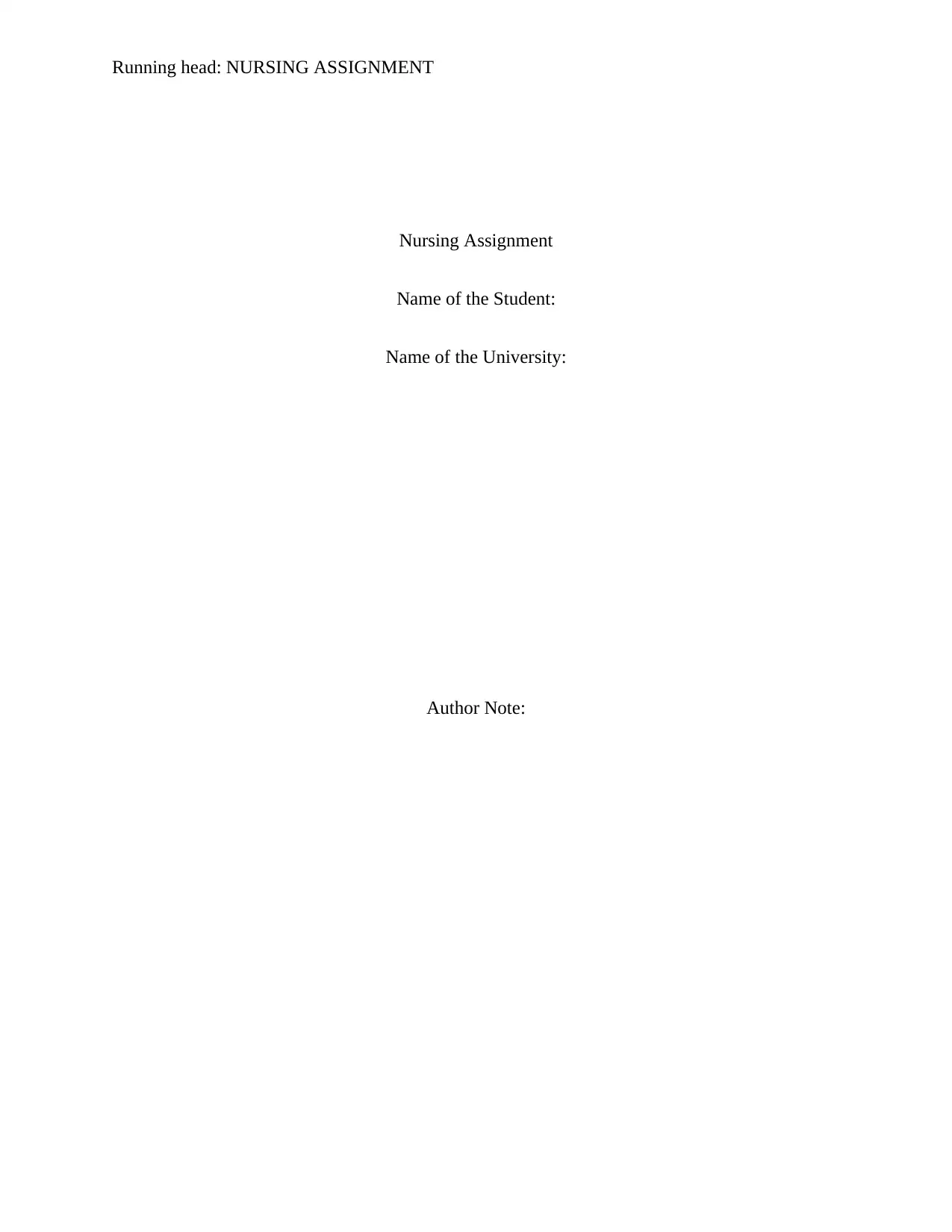
Running head: NURSING ASSIGNMENT
Nursing Assignment
Name of the Student:
Name of the University:
Author Note:
Nursing Assignment
Name of the Student:
Name of the University:
Author Note:
Paraphrase This Document
Need a fresh take? Get an instant paraphrase of this document with our AI Paraphraser
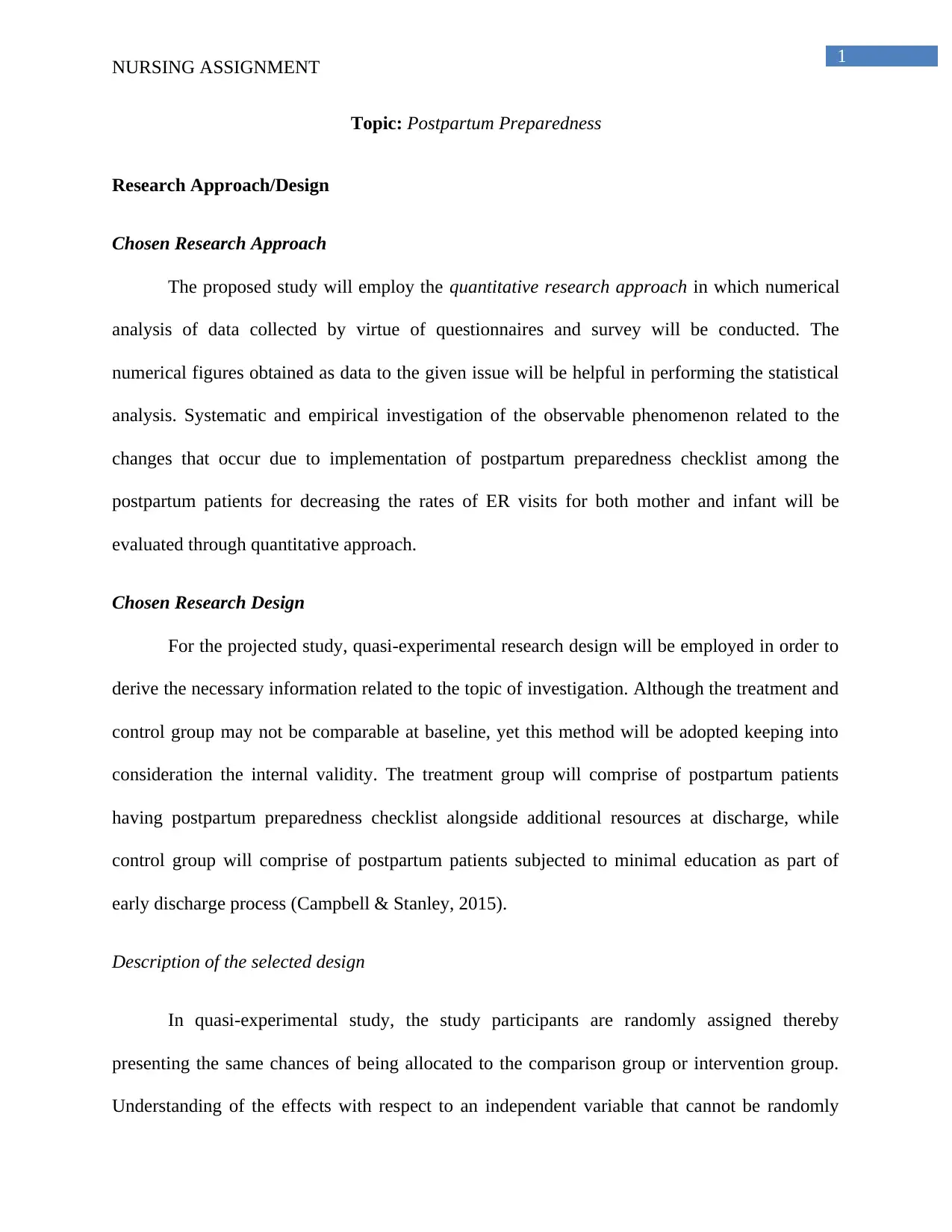
1
NURSING ASSIGNMENT
Topic: Postpartum Preparedness
Research Approach/Design
Chosen Research Approach
The proposed study will employ the quantitative research approach in which numerical
analysis of data collected by virtue of questionnaires and survey will be conducted. The
numerical figures obtained as data to the given issue will be helpful in performing the statistical
analysis. Systematic and empirical investigation of the observable phenomenon related to the
changes that occur due to implementation of postpartum preparedness checklist among the
postpartum patients for decreasing the rates of ER visits for both mother and infant will be
evaluated through quantitative approach.
Chosen Research Design
For the projected study, quasi-experimental research design will be employed in order to
derive the necessary information related to the topic of investigation. Although the treatment and
control group may not be comparable at baseline, yet this method will be adopted keeping into
consideration the internal validity. The treatment group will comprise of postpartum patients
having postpartum preparedness checklist alongside additional resources at discharge, while
control group will comprise of postpartum patients subjected to minimal education as part of
early discharge process (Campbell & Stanley, 2015).
Description of the selected design
In quasi-experimental study, the study participants are randomly assigned thereby
presenting the same chances of being allocated to the comparison group or intervention group.
Understanding of the effects with respect to an independent variable that cannot be randomly
NURSING ASSIGNMENT
Topic: Postpartum Preparedness
Research Approach/Design
Chosen Research Approach
The proposed study will employ the quantitative research approach in which numerical
analysis of data collected by virtue of questionnaires and survey will be conducted. The
numerical figures obtained as data to the given issue will be helpful in performing the statistical
analysis. Systematic and empirical investigation of the observable phenomenon related to the
changes that occur due to implementation of postpartum preparedness checklist among the
postpartum patients for decreasing the rates of ER visits for both mother and infant will be
evaluated through quantitative approach.
Chosen Research Design
For the projected study, quasi-experimental research design will be employed in order to
derive the necessary information related to the topic of investigation. Although the treatment and
control group may not be comparable at baseline, yet this method will be adopted keeping into
consideration the internal validity. The treatment group will comprise of postpartum patients
having postpartum preparedness checklist alongside additional resources at discharge, while
control group will comprise of postpartum patients subjected to minimal education as part of
early discharge process (Campbell & Stanley, 2015).
Description of the selected design
In quasi-experimental study, the study participants are randomly assigned thereby
presenting the same chances of being allocated to the comparison group or intervention group.
Understanding of the effects with respect to an independent variable that cannot be randomly
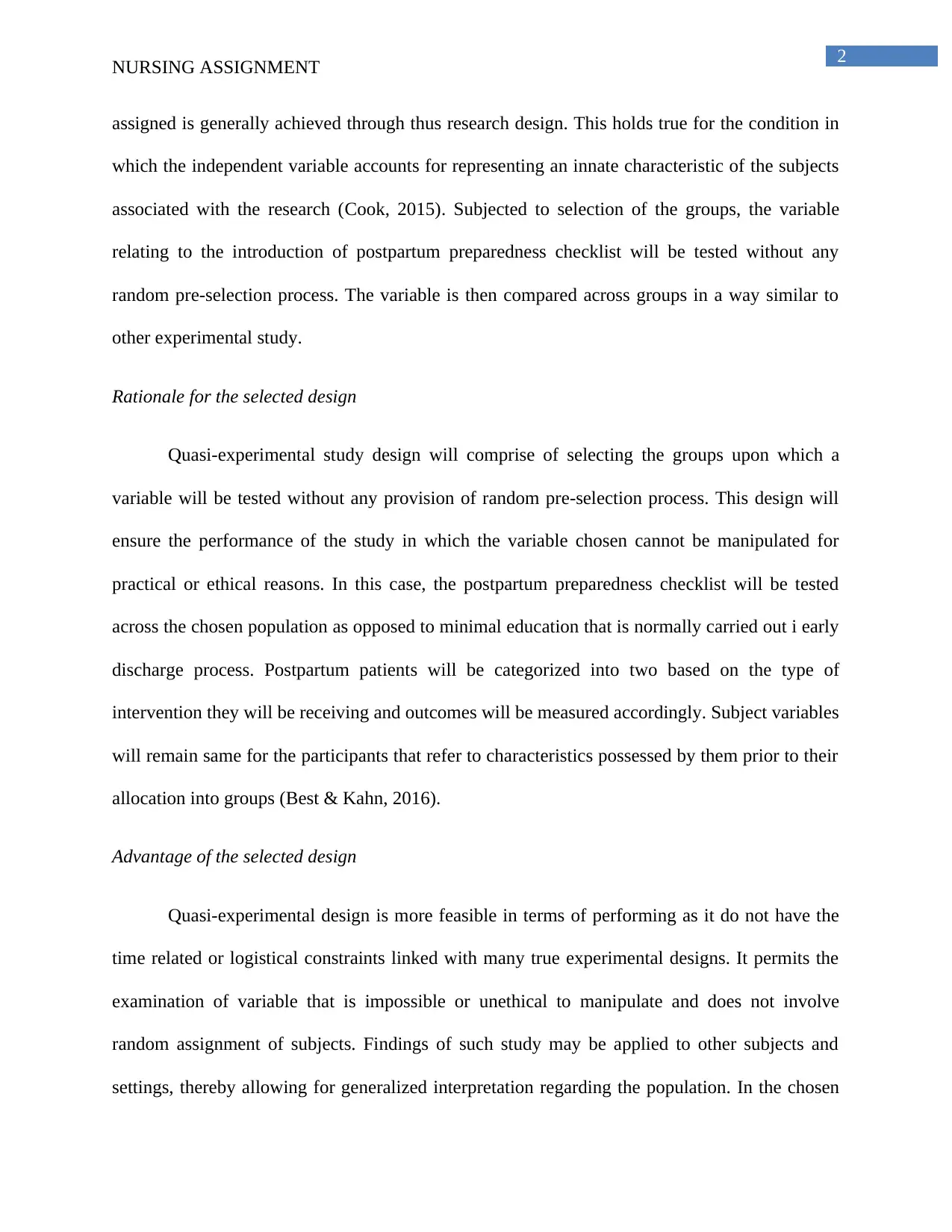
2
NURSING ASSIGNMENT
assigned is generally achieved through thus research design. This holds true for the condition in
which the independent variable accounts for representing an innate characteristic of the subjects
associated with the research (Cook, 2015). Subjected to selection of the groups, the variable
relating to the introduction of postpartum preparedness checklist will be tested without any
random pre-selection process. The variable is then compared across groups in a way similar to
other experimental study.
Rationale for the selected design
Quasi-experimental study design will comprise of selecting the groups upon which a
variable will be tested without any provision of random pre-selection process. This design will
ensure the performance of the study in which the variable chosen cannot be manipulated for
practical or ethical reasons. In this case, the postpartum preparedness checklist will be tested
across the chosen population as opposed to minimal education that is normally carried out i early
discharge process. Postpartum patients will be categorized into two based on the type of
intervention they will be receiving and outcomes will be measured accordingly. Subject variables
will remain same for the participants that refer to characteristics possessed by them prior to their
allocation into groups (Best & Kahn, 2016).
Advantage of the selected design
Quasi-experimental design is more feasible in terms of performing as it do not have the
time related or logistical constraints linked with many true experimental designs. It permits the
examination of variable that is impossible or unethical to manipulate and does not involve
random assignment of subjects. Findings of such study may be applied to other subjects and
settings, thereby allowing for generalized interpretation regarding the population. In the chosen
NURSING ASSIGNMENT
assigned is generally achieved through thus research design. This holds true for the condition in
which the independent variable accounts for representing an innate characteristic of the subjects
associated with the research (Cook, 2015). Subjected to selection of the groups, the variable
relating to the introduction of postpartum preparedness checklist will be tested without any
random pre-selection process. The variable is then compared across groups in a way similar to
other experimental study.
Rationale for the selected design
Quasi-experimental study design will comprise of selecting the groups upon which a
variable will be tested without any provision of random pre-selection process. This design will
ensure the performance of the study in which the variable chosen cannot be manipulated for
practical or ethical reasons. In this case, the postpartum preparedness checklist will be tested
across the chosen population as opposed to minimal education that is normally carried out i early
discharge process. Postpartum patients will be categorized into two based on the type of
intervention they will be receiving and outcomes will be measured accordingly. Subject variables
will remain same for the participants that refer to characteristics possessed by them prior to their
allocation into groups (Best & Kahn, 2016).
Advantage of the selected design
Quasi-experimental design is more feasible in terms of performing as it do not have the
time related or logistical constraints linked with many true experimental designs. It permits the
examination of variable that is impossible or unethical to manipulate and does not involve
random assignment of subjects. Findings of such study may be applied to other subjects and
settings, thereby allowing for generalized interpretation regarding the population. In the chosen
⊘ This is a preview!⊘
Do you want full access?
Subscribe today to unlock all pages.

Trusted by 1+ million students worldwide
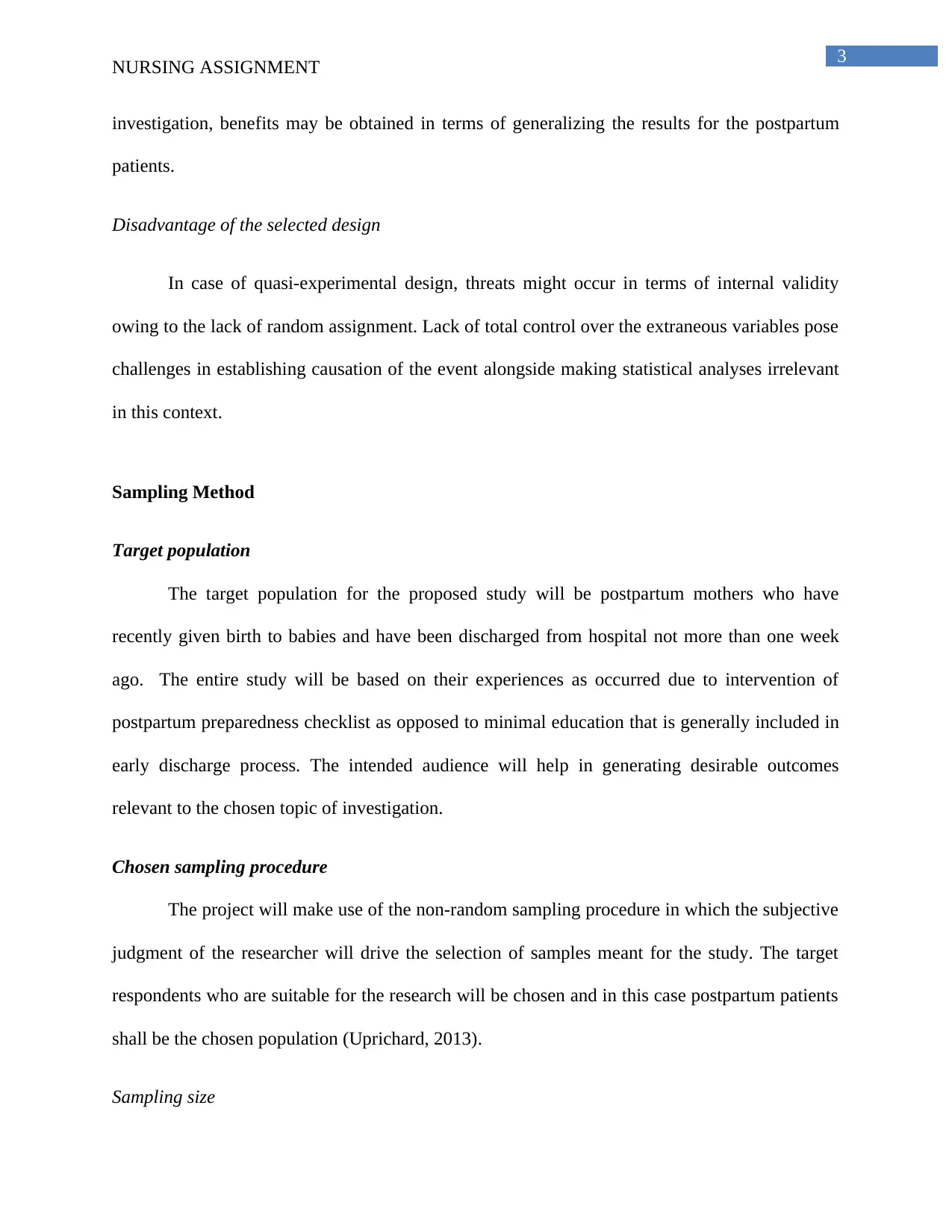
3
NURSING ASSIGNMENT
investigation, benefits may be obtained in terms of generalizing the results for the postpartum
patients.
Disadvantage of the selected design
In case of quasi-experimental design, threats might occur in terms of internal validity
owing to the lack of random assignment. Lack of total control over the extraneous variables pose
challenges in establishing causation of the event alongside making statistical analyses irrelevant
in this context.
Sampling Method
Target population
The target population for the proposed study will be postpartum mothers who have
recently given birth to babies and have been discharged from hospital not more than one week
ago. The entire study will be based on their experiences as occurred due to intervention of
postpartum preparedness checklist as opposed to minimal education that is generally included in
early discharge process. The intended audience will help in generating desirable outcomes
relevant to the chosen topic of investigation.
Chosen sampling procedure
The project will make use of the non-random sampling procedure in which the subjective
judgment of the researcher will drive the selection of samples meant for the study. The target
respondents who are suitable for the research will be chosen and in this case postpartum patients
shall be the chosen population (Uprichard, 2013).
Sampling size
NURSING ASSIGNMENT
investigation, benefits may be obtained in terms of generalizing the results for the postpartum
patients.
Disadvantage of the selected design
In case of quasi-experimental design, threats might occur in terms of internal validity
owing to the lack of random assignment. Lack of total control over the extraneous variables pose
challenges in establishing causation of the event alongside making statistical analyses irrelevant
in this context.
Sampling Method
Target population
The target population for the proposed study will be postpartum mothers who have
recently given birth to babies and have been discharged from hospital not more than one week
ago. The entire study will be based on their experiences as occurred due to intervention of
postpartum preparedness checklist as opposed to minimal education that is generally included in
early discharge process. The intended audience will help in generating desirable outcomes
relevant to the chosen topic of investigation.
Chosen sampling procedure
The project will make use of the non-random sampling procedure in which the subjective
judgment of the researcher will drive the selection of samples meant for the study. The target
respondents who are suitable for the research will be chosen and in this case postpartum patients
shall be the chosen population (Uprichard, 2013).
Sampling size
Paraphrase This Document
Need a fresh take? Get an instant paraphrase of this document with our AI Paraphraser
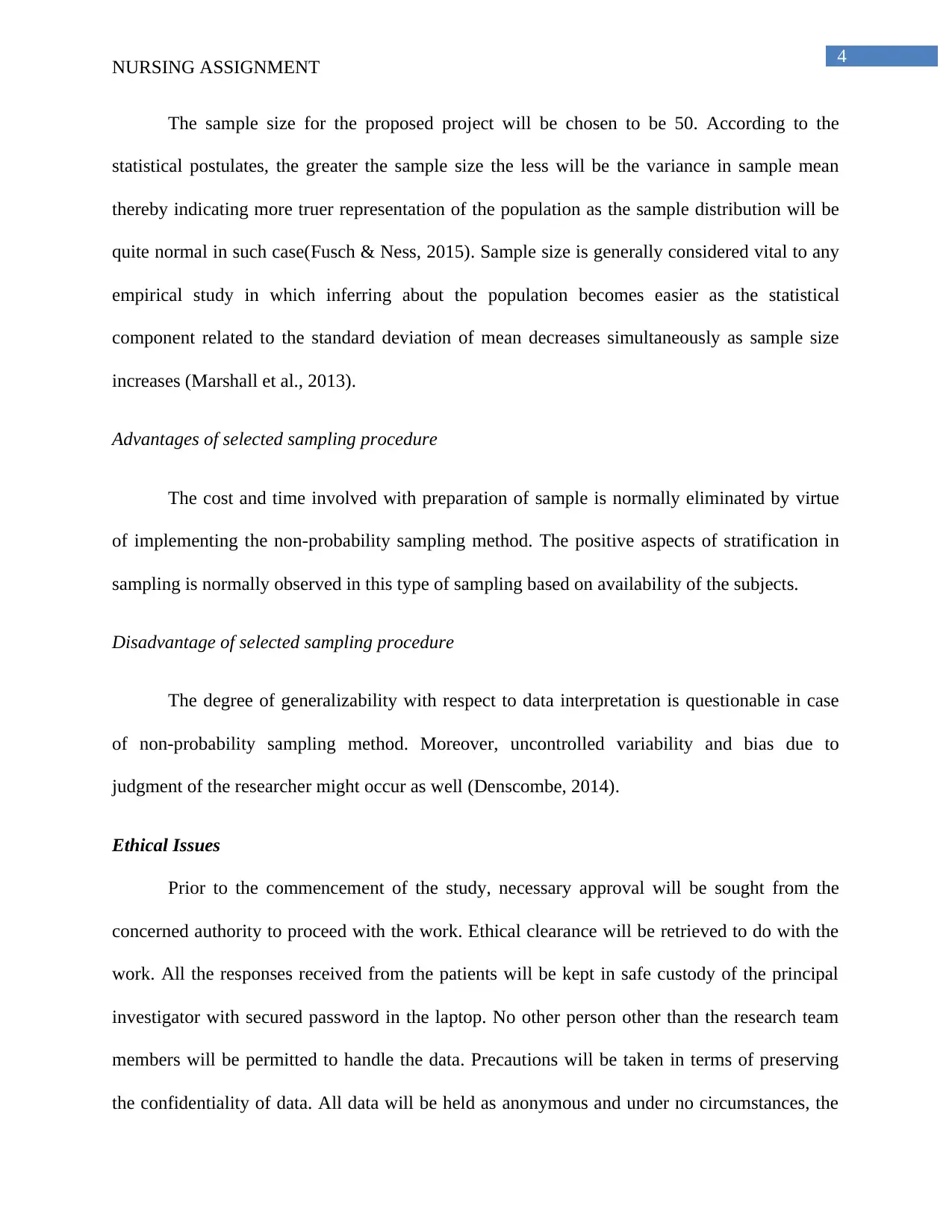
4
NURSING ASSIGNMENT
The sample size for the proposed project will be chosen to be 50. According to the
statistical postulates, the greater the sample size the less will be the variance in sample mean
thereby indicating more truer representation of the population as the sample distribution will be
quite normal in such case(Fusch & Ness, 2015). Sample size is generally considered vital to any
empirical study in which inferring about the population becomes easier as the statistical
component related to the standard deviation of mean decreases simultaneously as sample size
increases (Marshall et al., 2013).
Advantages of selected sampling procedure
The cost and time involved with preparation of sample is normally eliminated by virtue
of implementing the non-probability sampling method. The positive aspects of stratification in
sampling is normally observed in this type of sampling based on availability of the subjects.
Disadvantage of selected sampling procedure
The degree of generalizability with respect to data interpretation is questionable in case
of non-probability sampling method. Moreover, uncontrolled variability and bias due to
judgment of the researcher might occur as well (Denscombe, 2014).
Ethical Issues
Prior to the commencement of the study, necessary approval will be sought from the
concerned authority to proceed with the work. Ethical clearance will be retrieved to do with the
work. All the responses received from the patients will be kept in safe custody of the principal
investigator with secured password in the laptop. No other person other than the research team
members will be permitted to handle the data. Precautions will be taken in terms of preserving
the confidentiality of data. All data will be held as anonymous and under no circumstances, the
NURSING ASSIGNMENT
The sample size for the proposed project will be chosen to be 50. According to the
statistical postulates, the greater the sample size the less will be the variance in sample mean
thereby indicating more truer representation of the population as the sample distribution will be
quite normal in such case(Fusch & Ness, 2015). Sample size is generally considered vital to any
empirical study in which inferring about the population becomes easier as the statistical
component related to the standard deviation of mean decreases simultaneously as sample size
increases (Marshall et al., 2013).
Advantages of selected sampling procedure
The cost and time involved with preparation of sample is normally eliminated by virtue
of implementing the non-probability sampling method. The positive aspects of stratification in
sampling is normally observed in this type of sampling based on availability of the subjects.
Disadvantage of selected sampling procedure
The degree of generalizability with respect to data interpretation is questionable in case
of non-probability sampling method. Moreover, uncontrolled variability and bias due to
judgment of the researcher might occur as well (Denscombe, 2014).
Ethical Issues
Prior to the commencement of the study, necessary approval will be sought from the
concerned authority to proceed with the work. Ethical clearance will be retrieved to do with the
work. All the responses received from the patients will be kept in safe custody of the principal
investigator with secured password in the laptop. No other person other than the research team
members will be permitted to handle the data. Precautions will be taken in terms of preserving
the confidentiality of data. All data will be held as anonymous and under no circumstances, the
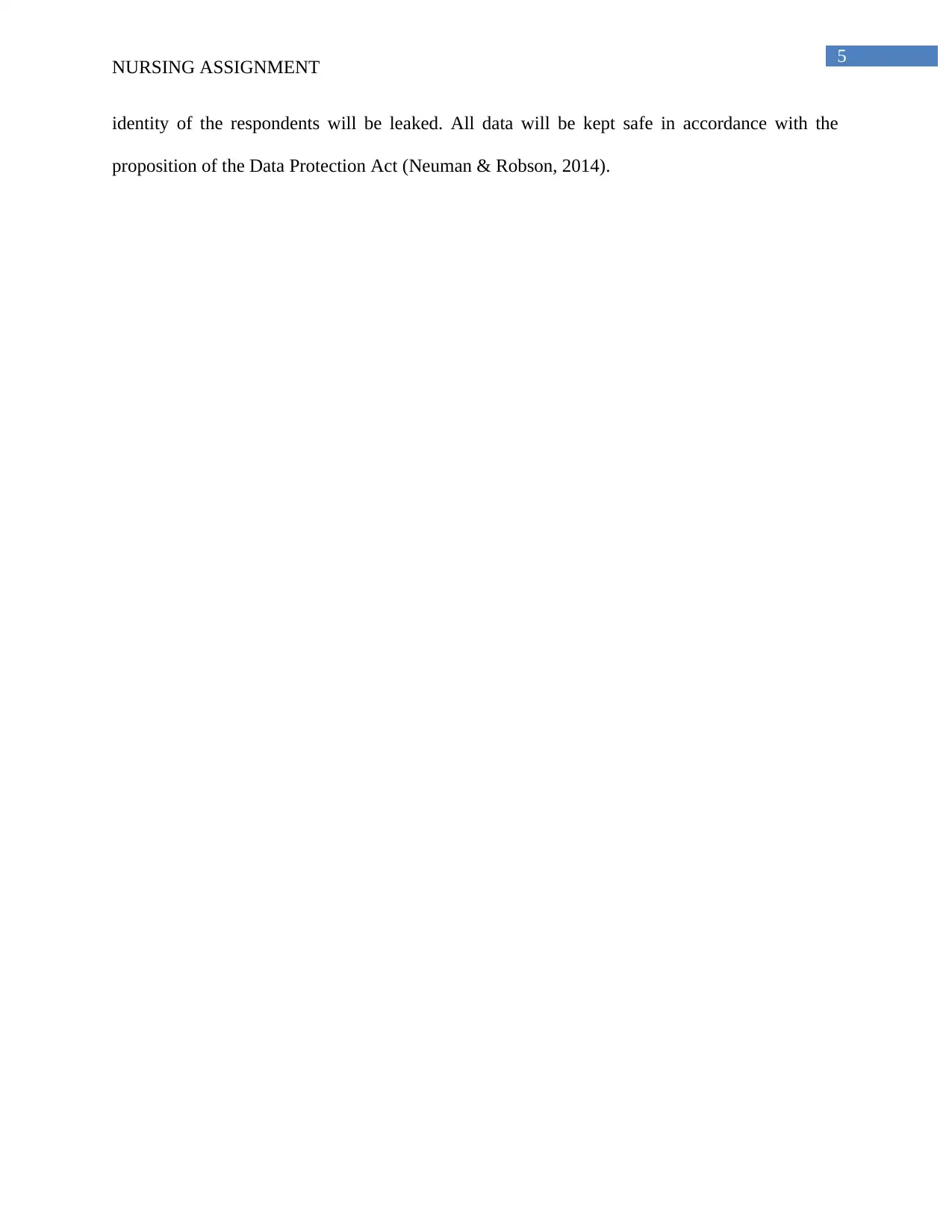
5
NURSING ASSIGNMENT
identity of the respondents will be leaked. All data will be kept safe in accordance with the
proposition of the Data Protection Act (Neuman & Robson, 2014).
NURSING ASSIGNMENT
identity of the respondents will be leaked. All data will be kept safe in accordance with the
proposition of the Data Protection Act (Neuman & Robson, 2014).
⊘ This is a preview!⊘
Do you want full access?
Subscribe today to unlock all pages.

Trusted by 1+ million students worldwide
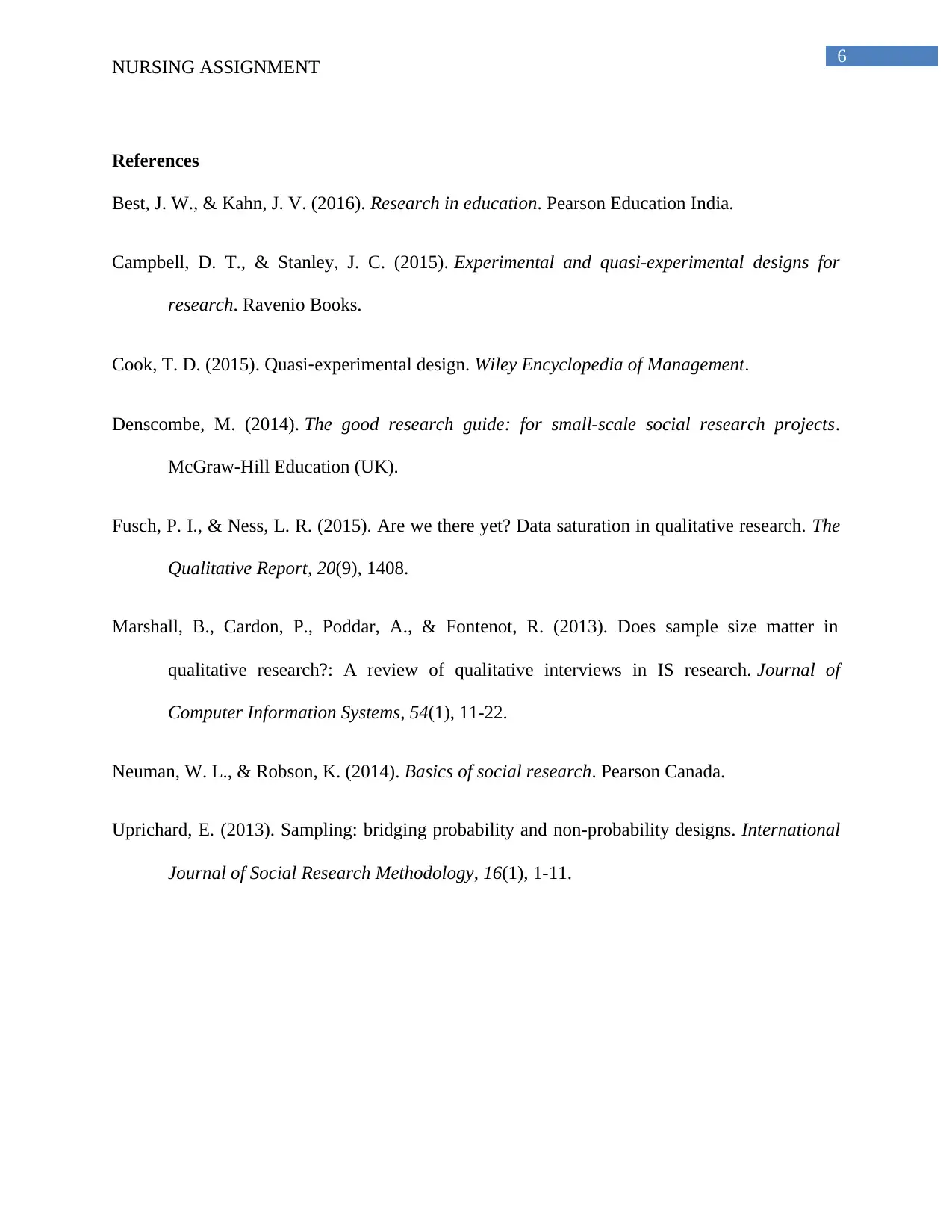
6
NURSING ASSIGNMENT
References
Best, J. W., & Kahn, J. V. (2016). Research in education. Pearson Education India.
Campbell, D. T., & Stanley, J. C. (2015). Experimental and quasi-experimental designs for
research. Ravenio Books.
Cook, T. D. (2015). Quasi‐experimental design. Wiley Encyclopedia of Management.
Denscombe, M. (2014). The good research guide: for small-scale social research projects.
McGraw-Hill Education (UK).
Fusch, P. I., & Ness, L. R. (2015). Are we there yet? Data saturation in qualitative research. The
Qualitative Report, 20(9), 1408.
Marshall, B., Cardon, P., Poddar, A., & Fontenot, R. (2013). Does sample size matter in
qualitative research?: A review of qualitative interviews in IS research. Journal of
Computer Information Systems, 54(1), 11-22.
Neuman, W. L., & Robson, K. (2014). Basics of social research. Pearson Canada.
Uprichard, E. (2013). Sampling: bridging probability and non-probability designs. International
Journal of Social Research Methodology, 16(1), 1-11.
NURSING ASSIGNMENT
References
Best, J. W., & Kahn, J. V. (2016). Research in education. Pearson Education India.
Campbell, D. T., & Stanley, J. C. (2015). Experimental and quasi-experimental designs for
research. Ravenio Books.
Cook, T. D. (2015). Quasi‐experimental design. Wiley Encyclopedia of Management.
Denscombe, M. (2014). The good research guide: for small-scale social research projects.
McGraw-Hill Education (UK).
Fusch, P. I., & Ness, L. R. (2015). Are we there yet? Data saturation in qualitative research. The
Qualitative Report, 20(9), 1408.
Marshall, B., Cardon, P., Poddar, A., & Fontenot, R. (2013). Does sample size matter in
qualitative research?: A review of qualitative interviews in IS research. Journal of
Computer Information Systems, 54(1), 11-22.
Neuman, W. L., & Robson, K. (2014). Basics of social research. Pearson Canada.
Uprichard, E. (2013). Sampling: bridging probability and non-probability designs. International
Journal of Social Research Methodology, 16(1), 1-11.
1 out of 7
Related Documents
Your All-in-One AI-Powered Toolkit for Academic Success.
+13062052269
info@desklib.com
Available 24*7 on WhatsApp / Email
![[object Object]](/_next/static/media/star-bottom.7253800d.svg)
Unlock your academic potential
Copyright © 2020–2025 A2Z Services. All Rights Reserved. Developed and managed by ZUCOL.





